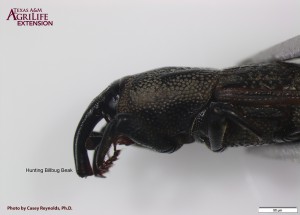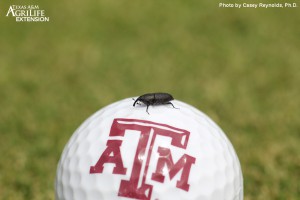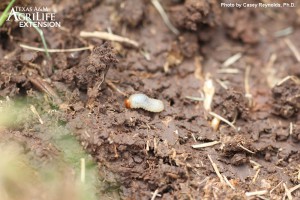Casey Reynolds, PhD, Mike Merchant, PhD and Diane Silcox Reynolds, PhD
Hunting Billbugs, Sphenophorus venatus vestitus Chittenden
Description


Life Cycle



Control Recommendations
Monitoring for hunting billbugs is easiest and most effective when scouting for the adult stage, because larvae are often only found in the turfgrass root zone and can be as deep as several inches in the soil. As a result, scouting for larvae means having to use destructive monitoring techniques to extract the larvae, which is often not acceptable in many turfgrass settings. Monitoring techniques for adult hunting billbugs are less damaging and include visual inspection of the turfgrass surface as well as using linear pitfall traps.

Adults begin to become active on the turfgrass surface during sunset and remain active until approximately one hour prior to sunrise, when they burrow deeper into the soil profile. As a result, scouting for adults immediately prior to or after sunset is the ideal time to observe adult activity (Figure 6). This is most easily performed by scouting for hunting billbugs using a flashlight to identify adults on the turfgrass surface. Once light from the flashlight disturbs the billbugs they often play dead, making them easy to collect and identify. Focusing on shorter mowed areas of turfgrass (<1”), i.e. the approach and collars of a golf course is the easiest place to find them, but if this is not possible it may be necessary to push apart the turfgrass to inspect for billbugs at or near the soil surface. One benefit of scouting for adults at night is that in addition to observing the presence of adults you can also record the magnitude of the population, which can help in determining if treatment thresholds have been exceeded.
Another scouting method, used principally in research, involves the use of linear pitfall traps, which can be used to collect adults without having to scout for them at night. Linear pitfall traps can be constructed using any type of plastic material with a smooth surface that prevents the adults from crawling out after they have fallen into the trap. They are often constructed using plastic gutters, PVC pipe cut in half, and even plastic cups. The objective when using this method is to install them at or near the soil surface such that when adults crawl across the turfgrass they will fall into the pitfall trap and not be able to escape. The traps can then be inspected the following morning for the presence of adult hunting billbugs. One point to be aware of when installing linear pitfall traps is to not construct them in a large enough fashion that they may pose a safety hazard to people or animals that may also encounter the traps at night.
Zoysia matrella cultivars appear to be more resistant to the feeding of hunting billbug compared to Z. japonica cultivars. In one study, ‘Diamond’, ‘Zorro’, and ‘Cavalier’ suffered significantly less damage to hunting bill bug than most japonica varieties. The most heavily damaged zoysia varieties included ‘Palisades’, ‘Meyer’, and ‘El Toro’.
Insecticide applications are most effective when timed to coincide with adult activity, or soon after larvae have hatched. Preventative treatment options for hunting billbugs that target egg hatch and small larvae include products containing chlorantraniliprole, clothianidin, imidacloprid, or thiamethoxam, while curative treatments targeting the adult stage include products containing bifenthrin, chlorpyrifos, deltamethrin, or lambda-cyhalothrin. For further product recommendations on hunting billbug control, please consult the Texas Turfgrass Pest Control Recommendations guide. As always, be sure to read and follow label directions for control recommendations and precautionary statements.